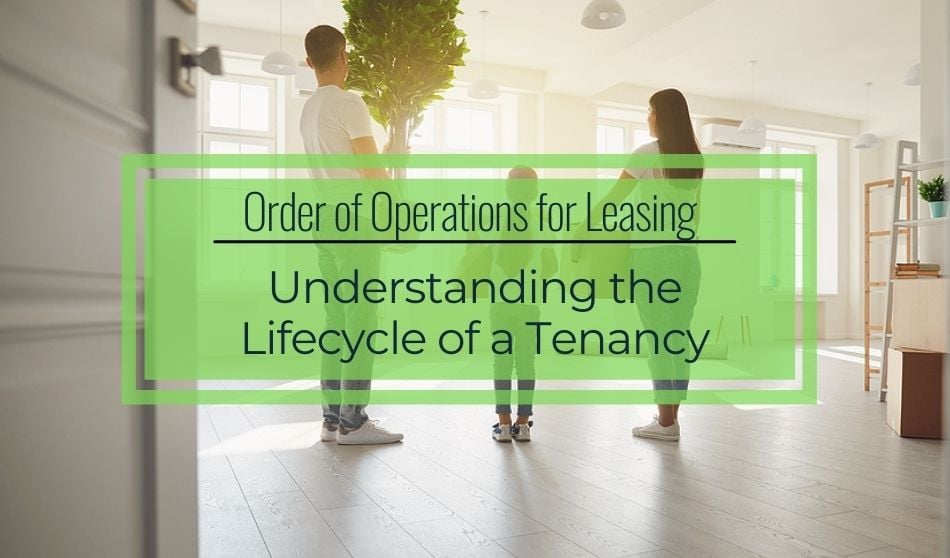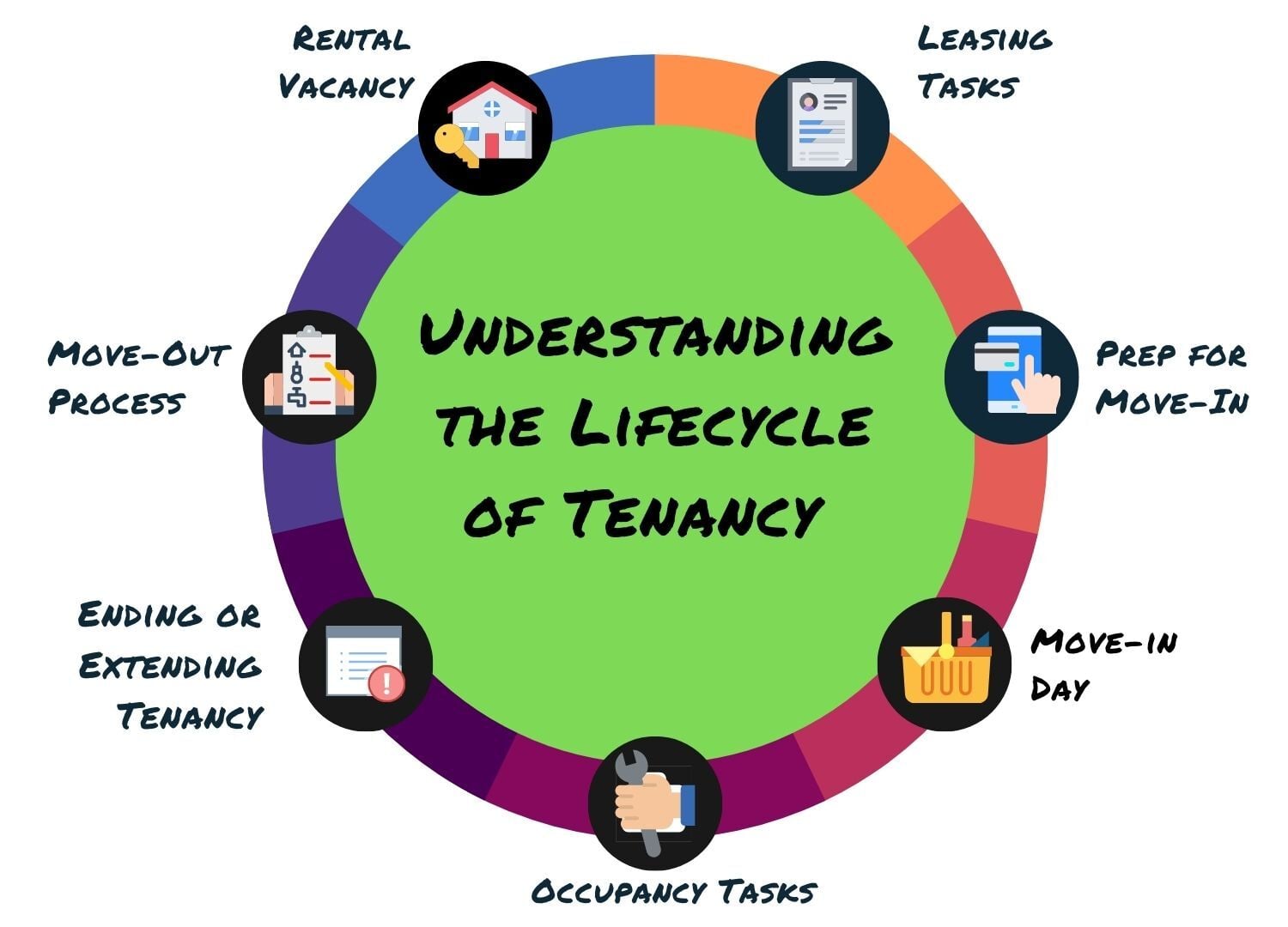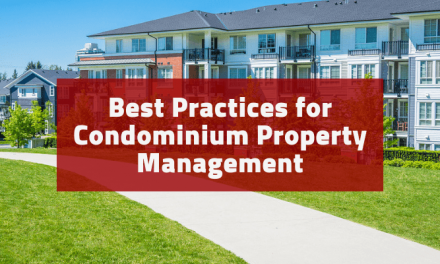
The order of operations for leasing can be tricky; especially if you’re new to the industry. If you’ve ever struggled to get the right answer to a complicated equation, there are handy acronyms and formulas to guide you. Without them, it’s easy to do all the hard work and yet come to a faulty conclusion.
The same concept rings true for property management. We’ve put together this handy outline to help you not only understand the lifecycle of a tenancy but give you a logical order of operations for leasing and vacancy processes.
In this article, we offer a one-stop-shop guide to the best rental industry articles which elaborate on those tasks to help you understand the lifecycle of a tenancy. Each cycle segment is organized in the most logical order for best practices and filled with resource links to additional comprehensive information on that topic and task.
Table of Contents:
Rental Vacancy
Leasing Tasks
Prep for Move-In
Move-In Day
Occupancy Tasks
Ending or Extending Tenancy
Move-Out Process

Rental Vacancy
Repairs and renovations — Now that the unit is empty it’s the perfect time to tackle repairs noted in the move-out inspection (see Move-Out Process below). It’s also the perfect time to check the base of the toilets for a good seal, flush the water heater, change the HVAC filters, and check fire and smoke alarms. Check out these articles for more inspiration to make the home tenant ready:
Preparing Your Rental for a New Tenant : Steps for a Smooth Turnover
7 Quick and Easy Home Updates to Make Before Your New Tenants Move In
10 Ways to Modernize Your Outdated Rental Property
Cleaning –– The unit should have been left clean by the former occupant but move-out clean doesn’t necessarily mean it’s ready for a photoshoot or prospective tenant showing. The cleanliness is a reflection of your business and an example of how you’d like the property treated. Areas often overlooked are the grooves in the seal around the refrigerator door, window blinds and tracks, fingerprints around light switches, and doorknobs. Remember to do a follow-up cleaning after repairs are completed and also routinely between vacancy showings.
Home & Office Cleaning Tips for a Safe Environment
What to do About Foul Odors at Your Rental Property
10 Must-Have Products to Deep Clean Your Rental
Photography — Shopping for housing online has become the norm. Now more than ever pictures need to showcase the rental home so be sure to get shots of each room at multiple angles. Online listing sites allow for a plethora of photos so don’t be shy to include pictures of the interior and exterior features of the home and community. Remember to open shades and turn on the lights to get the best shots.
How to Take Better Rental Listing Photos
Drone Photography for Property Managers and Landlords
Create or Review the Rental Listing — If a picture paints 1000 words, the listing should corroborate that story. Elaborate on the location, pricing, obvious features, unique features, benefits, community, approval criteria, and application and renting expectations.
Best Rental Sites & Advice to Fill Vacancies | Anatomy of a Rental Listing
How to Find Fair Market Rent for your Rentals
Marketing — You’ve got the pictures and the rental listing — it’s now time to use those to your advantage in marketing efforts.
– Syndicate to rental listing sites online through your property management software.
– Print flyers and put them up on college boards, community bulletin boards, and even laundromats.
– Other options include ordering and hanging banners and yard signs and posting the vacancy in your community newsletter.
– Think about offering a referral incentive to the tenants in that community.
Check out these article for more great rental marketing ideas:
Easy Rental Real Estate Marketing Ideas for the Busy Landlord
Best Marketing Tips for Filing Rental Vacancies Fast
How to Advertise Your Empty Unit
Rental Prospect Engagement — The above 5 items are usually a once and done activity whereas these next 5 will cycle through with each prospect; and it starts by engagement. The word is getting out, your phone is ringing and your email inbox is overflowing with interest. Fantastic! In this phase, you’ll be busy answering questions, restating the rental criteria, application process, renting expectations, and setting appointments to show the unit.
The Easiest Tenant Lead Tracking Solution (That Actually Works!)
Best Communication Tips for Landlords
Questions to Ask Your New Landlord – Before Signing a Lease
Rental Showings — Showing a vacant rental has become a little more tricky in this new remote paradigm. But with new challenges come new opportunities to meet them. Virtual reality software and hardware is bleeding-edge technology that hasn’t hit mainstream as yet but may turn out to be common practice one day. Until then, the four best options for showing your vacant rentals are:
– In-person showing where both you and they meet together at the unit.
– Self-guided tour allows the prospect an opportunity to walk around unaccompanied.
– Virtual tour with the prospect on-site while they have you accompany them on a smartphone or device.
– Virtual tour where the prospect is virtual while you walk the unit with your smartphone or device.
Whichever method you choose, be sure to offer a packet (tangible or virtual) that includes an application, flyer, community information, and rental criteria.
Application review and tenant interviews — In many states, it is required to process each application one-at-a-time and/or in the order received. If the application is denied, then the next one received is processed. In other states, you may be allowed to review and process multiple applications concurrently giving the unit to the first applicant who meets all the criteria. It is important to review your state regulations prior to processing applications. If your state has no regulations it’s best to conduct the following actions in this order:
- Review the application to make sure no section or question has been left blank.
- Check legibility as soon as it is received and don’t be shy to point out if it’s unreadable. One way to avoid dealing with hard-to-read applications is by using property management software that provides a built-in electronic application.
- Be sure it has signatures allowing for background and credit checks.
The Power of Online Rental Applications to Fill Vacancies Fast
- Call current and previous landlords, work references, and character references.
How to Tell if Your Rental Applicant’s Landlord Reference is Fake
- Confirm they have submitted all the documentation requested
- Review documentation
- Conduct a tenant interview
How to Create Written Tenant Screening Criteria
The DOS and Dont’s of a Tenant Interview
Take a Chance on First Time Renters
How to Find Good Tenants For a Rental Property
Tenant Screening: Background & Credit Checks — Tenant screening is a vital part of the vetting process and so important to follow best practices according to your state regulations. We’ve put together some resources to help you find the best success with the process:
The Ultimate Guide to Tenant Screening for Landlords
Avoid Fair Housing Lawsuits: How to Create Written Tenant Screening Criteria
Legal Tenant Screening Criteria Checklist: Infographic
5 Mistakes to Avoid When Screening a Tenant
Handling Application Results — Many landlords don’t know the importance of communicating the outcome of an application to every applicant. Letting every applicant know their standing helps avoid situations that could be misconstrued as discriminatory and will cut down on the follow-up calls and emails received. An applicant will fall under one of these three categories:
- Not processed because the unit is no longer available, the application is incomplete, or application documentation missing.
- Denied. Every applicant that is denied must be given an adverse action letter also known as a denial letter. There are templates and resources available in the links below.
- Accepted. Just like a formal job offer, it’s a good practice to create a rental acceptance letter restating the address of the home, the rental rate agreed on, move-in fees, and information about when they can expect to have a lease to review and sign
How to Avoid a Risky Rental Situation
Legal Requirements for Denying a Rental Application (Adverse Action Letter)
Leasing Tasks
The lease signing process has much to do with creating the lease agreement, and on that topic, we’ve got you covered:
Schedule move-in Date and Calculate Move-in Costs
4 Ways to Calculate Prorated Rent: Plus Bonus Tools & Resources
Create the Lease
Pros and Cons of a Fixed-Term Lease Versus a Month-to-Month Lease
Landlord Disclosures: What you Have to Tell Your Tenant – State Guide
Lease Signing
The Lease Signing Process for Landlords (and tenants)
What is an eSignature and How are They Useful for Landlords?
Prep for Move-in Day
To ensure your tenants have the best experience, it starts with the preparation for the big day.
Create a Tenant Portal
Enable the Online Payment Options
Communicate Move-In Logistics and Review Rules & Regulations — Reach out to your future tenants before the beginning of their lease to communicate the move-in day logistics. Most people grab a couple of friends to help so be sure to let your tenant know where their friends can park on the big day. Don’t forget to let them know the quiet hours and best placement for the moving van.
Remember to instruct them when and where they can pick up the keys to the rental home. Review the rules and regulations with them prior to move-in. Many landlords suggest having those written or restated in a separate document that you and your tenant initial as reviewed. Lastly, you may want to also share with them this handy guide for understanding the terms of their lease before move-in.
Collect Move-In Funds and Hand Out Keys — after that, be sure to help them understand how to log into their tenant portal and what move-in fees are still outstanding and required before receiving their keys (such as the security deposit, first and last months rent, and other fees).
Trending Security Deposit Flexibility and Renters Choice Legislation
Move-in Day
With the activity of moving in, it can be a stressful time for your new tenant. We suggest making it as stress-free as possible for them with these handy tips.
Important Reminders for a Stress Free Moving Day
5 Must-Dos for Making a Great First Impression With Your Tenants
The Perfect Tenant Welcome Basket Recipe
Simple Ways to Make Tenants Feel at Home
How to Make a Rental Property More Welcoming for a New Tenant
Occupancy Tasks
Now the real fun begins. This category has its own lifecycle of activity that really is the heart of property management and tenant relations. Below you’ll find useful articles on every aspect to keep the wheels turning and build a long-lasting relationship of trust and mutual respect with your residents.
Rent Collection
A Landlord’s Guide to Rent Collection | Late Payments and Past Rent Debt
The Best Way to Collect Rent From Your Tenant
Guide to Late Rent Fees for Landlords and Property Managers
A Modern Rent Payment Option for Money Orders, Cash, and Checks
Accepting Cash Rent Payments Made Easy | Bonus: Tenant Handouts Included
Routine Inspections
Virtual Inspections Keep Renters Safe and Promote Social Distancing
Important Inspections for Your Rental Property
Rental repairs and maintenance requests
Ultimate Guide: Rental Property Maintenance
How to Prioritize Maintenance Requests
Complaints
How Can Landlords Deal with Noise Complaints?
Top Renter Complaints and How to Manage Them (bonus: Video)
Fighting Tenants: A Guide to Managing Tenant Drama
A Landlord’s Guide to Handling Difficult People
Lease violations
Retention
Top 10 Ways to Drive Away Tenants (and How to Avoid Them)
The Real Cost of Tenant Turnover
Why is Having a Great Landlord-Tenant Relationship Important?
Resident Retention & Stress Free Property Management: A Gratitude & Mindfulness Approach
Ending or Extending Tenancy
When a lease term has ended you have the opportunity to offer an extension (as either a renewal or a month-to-month agreement) or part ways. The end of a tenancy can be driven by many factors like a direct consequence of a lease violation or a tenant wanting to explore another opportunity.
Ending a Tenancy — To end a lease or rental agreement written communication is required and oftentimes must follow a specific state-regulated form. If a tenant intends to move, they need to provide you with a letter of intent to move. If you are ending the relationship, you would send them a notice to vacate. For example, a landlord may send a notice to vacate when the lease is about to expire and a tenant may reply by sending a letter of intent to move. The purpose of these written documents is to make sure the relationship that the lease created is ended in a legal and professional manner.
It’s important to not go rogue when ending a tenant-landlord relationship, especially in the case of a lease violation or eviction. These legal matters are best addressed by seeking a lawyer familiar with rental real estate and eviction laws for counsel.
What to Do When a Tenant Wants to Break Their Lease
How to Legally Evict a Tenant (bonus Video)
An Inside Look at Squatter’s Rights
Extending Tenancy — If neither party is looking to end the relationship at the end of a lease term, there are two options: a lease renewal, or a month-to-month rental agreement.
Should I Renew My Lease Agreement with My Tenant?
How to Increase Renewal Rates
Move-out Process
The time has come for the current tenant to move on to another home before the lifecycle of a tenancy begins anew. We have a few guides to that process available here:
Tenant Turnover: The Move-Out Process
Overcoming Lost Revenue During Tenant Turnover
With the above, here are some important tasks to tackle in the move-out process such as:
- Conduct a pre-move-out inspection so the tenant knows what items they will need to clean or repair before moving to ensure they receive their security deposit back in full.
- Just like the move-in process, communicate logistics and timing for returning keys, designate van and helper parking, and establish quiet hours.
- Conduct a move-out inspection to see if there are any outstanding areas that need to be cleaned, renovated, or repaired for the above Rental Vacancy stage.
- Calculate the disposition of the security deposit. If the tenant is not responsible for cleaning or damage repair costs then this a simple process where (depending on state regulations) the security deposit would be returned less any outstanding rent.
However, if there are damages and cleaning fees, this is where the first category of Rental Vacancy can overlap with the move-out process as you’ll need to wait for those tasks to be completed to be able to calculate how much to deduct from the security deposit.
Either way, check your local and state laws to make sure you are properly documenting and processing the security deposit, last month’s rent, and other financials related to this move-out process.
Security Deposit Laws: The Complete State Guide for Rental Properties
When can a Landlord Deduct from a Security Deposit?
The Ultimate Landlord Tenant Checklist
Above we began with an empty unit and the tasks that revolve around filling that rental vacancy. Next, we encountered lease signing activities and the big move-in day. Starting day one of tenancy another cycle of events being until the relationship ends with the move-out process and the lifecycle begins anew.
Almost everything in life has its seasons and cycles — from the mundane to the ebb and flow of the seasons themselves. The order of operation for leasing that helps us understand the lifecycle of a tenancy is no exception.
If we want to know more about property management, real estate investing, landlord tips, and the like, we encourage you to go to the blog and enter your email address to subscribe and receive notifications of new posts by email.





